An exploration of biblical heroines reveals unexpected tales of valor and leadership, inviting a reevaluation of strength and courage.
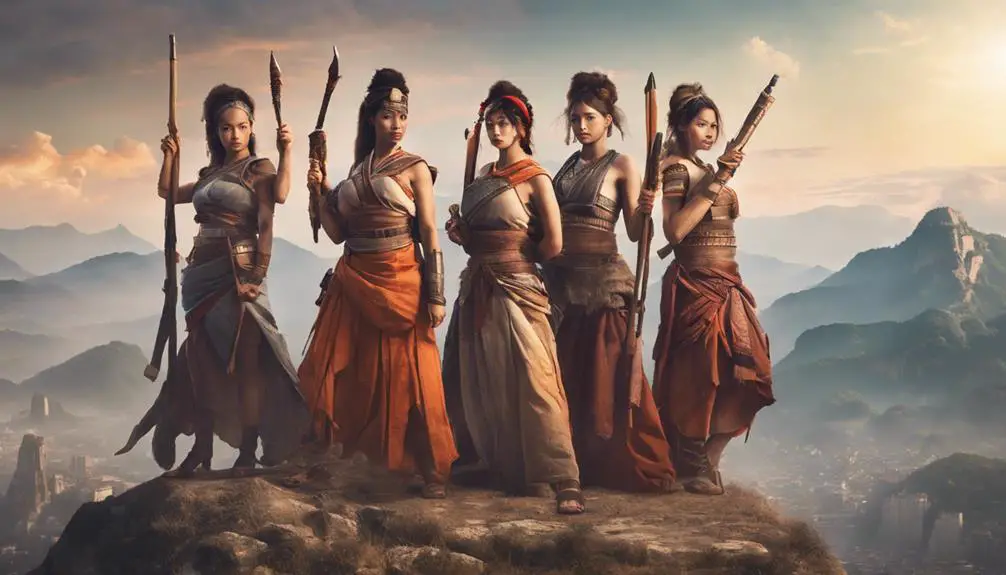
Women Warriors in the Bible
Despite what you might think, the Bible isn't shy about showcasing strong women; in fact, it recounts the stories of several who weren't just participants in the shadows but pivotal warriors and leaders.
Take Deborah, for instance, a prophetess and judge who led a nation to victory, or Jael, who decisively turned the tide of a battle with a single act of bravery. Their stories, along with others like Judith and the Daughters of Zelophehad, challenge traditional perceptions and invite you to explore these narratives further.
Why might their stories resonate today, and how do they redefine the concept of strength and leadership?
Key Takeaways
- Biblical women like Deborah and Jael showcased courage and leadership in combat situations.
- Jael and Judith exemplified strategic thinking and bravery through their decisive actions against oppressors.
- The stories of these women challenge traditional gender roles and expectations in their societies.
- Their legacies inspire future generations to advocate for rights and equality, illustrating the profound impact of their actions.
Deborah: Prophetess and Judge
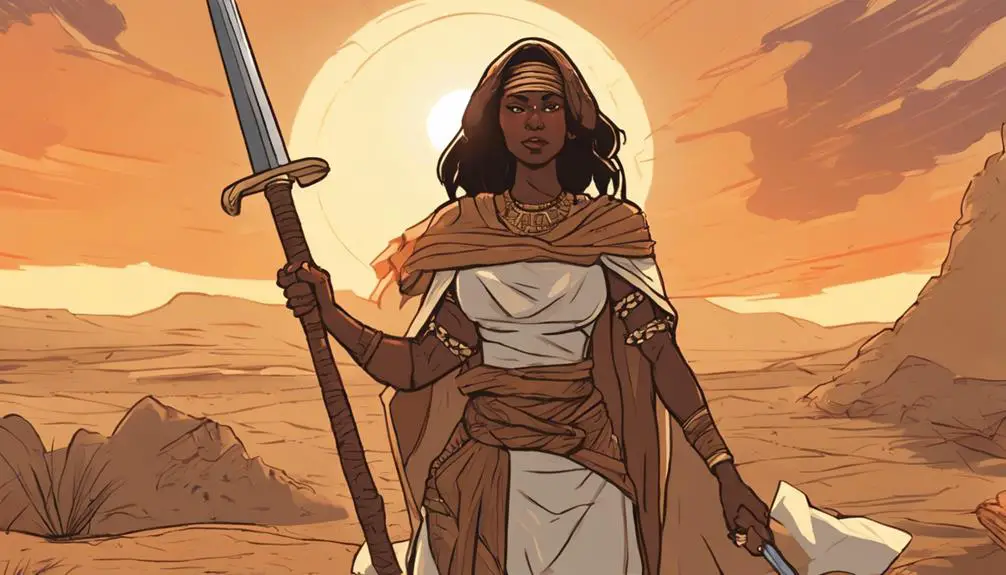
Deborah stands out as a unique figure in the Bible, serving both as a prophetess and a judge, guiding the Israelites with wisdom and courage. Her leadership during a tumultuous period for her people is noteworthy, not just for her role in delivering them from Canaanite oppression, but also for the spiritual and moral guidance she provided. Deborah's story, encapsulated in the Book of Judges, chapters 4 and 5, highlights her exceptional qualities and her pivotal role in Israelite history.
A critical aspect of Deborah's leadership was her use of Biblical songs, particularly evident in the Song of Deborah, one of the oldest and most significant pieces of poetry in the Bible. This song not only celebrates the victory over the Canaanites but also serves as a powerful tool of communal memory, reminding the Israelites of their shared history and God's deliverance. Through these songs, Deborah's leadership transcended mere military success, weaving her wisdom, faith, and courage into the fabric of Israelite culture and spirituality. Her story, therefore, isn't just a tale of triumph but a testament to the enduring power of faith and leadership.
Jael: The Tent Peg Heroine
Another remarkable woman whose story intertwines with the era of Judges is Jael, known for her decisive role in the battle against the Canaanites. Jael's actions are emblematic of a deeper understanding of tent construction and ancient hospitality, which she leveraged with profound courage and intelligence.
In the narrative, Jael invites the fleeing Canaanite general Sisera into her tent, a gesture deeply rooted in the customs of ancient hospitality. This act of welcoming, however, sets the stage for a dramatic turn of events. Understanding the construction of her own tent, Jael uses a tent peg as a weapon in a moment of extreme bravery, decisively ending Sisera's life and, by extension, the threat he posed to Israel.
This story, while violent, underscores the strategic and bold nature of Jael's actions within the context of her time. Her knowledge of tent construction wasn't merely practical but became instrumental in her contribution to the victory of Israel over the Canaanites. Jael's story serves as a testament to the unexpected ways in which courage and intellect can manifest, challenging the traditional expectations of women in ancient societies.
Judith: The Beheader of Holofernes
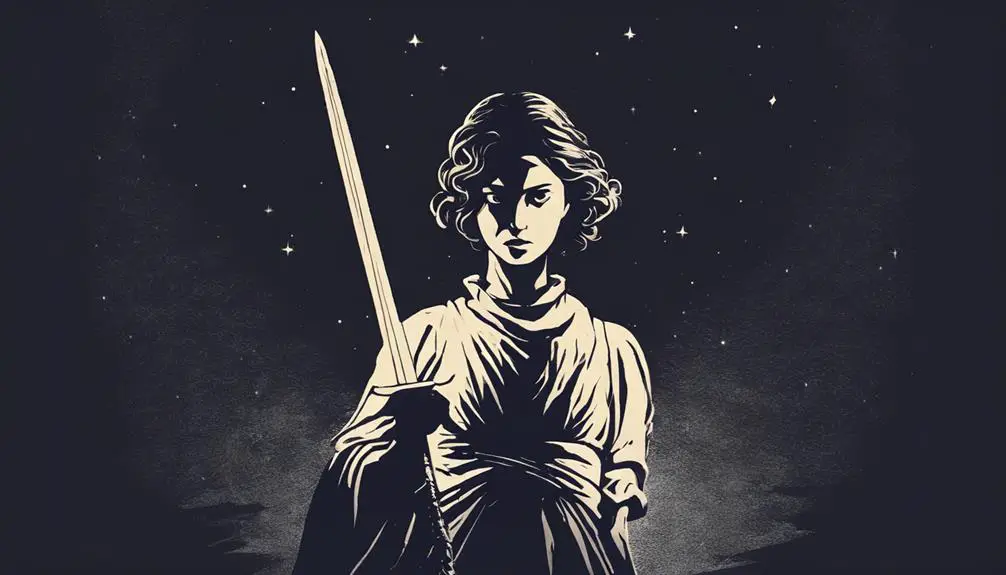
In the narrative of Judith, we encounter a daring heroine who, through a daring act of subterfuge and courage, successfully beheads Holofernes, thereby saving her people from oppression. Judith's story is not just a tale of bravery; it's a complex interplay of holiness and strategy. She uses her piety and wisdom to navigate through a dangerous mission, embodying the virtue of faith in action.
Artistic interpretations of Judith's story have varied widely, capturing the dramatic moment of Holofernes' beheading with a range of emotions from triumph to solemnity. These artworks not only celebrate Judith's courage but also delve into the moral and spiritual dimensions of her act.
Aspect |
Description |
Significance |
|---|---|---|
Holiness |
Judith's faith and prayer guide her actions. |
Highlights the role of divine guidance in achieving victory against seemingly insurmountable odds. |
Strategy |
Uses her intellect and womanly wiles to infiltrate the enemy camp. |
Demonstrates the power of strategy and cunning over brute force. |
Artistic Interpretations |
Vary from depicting Judith as a figure of valor to a symbol of divine vengeance. |
Reflects the enduring fascination and complexity of Judith's story across cultures and eras. |
Judith's tale is a profound reminder of the strength found in faith and cleverness, inspiring generations through biblical narrative and artistic rendition alike.
Jephthah's Daughter: Sacrifice and Honor
How does the story of Jephthah's daughter, a narrative steeped in sacrifice and honor, challenge our understanding of faith and duty in the biblical context? This tale isn't just a historical recount; it's a profound exploration of vow consequences and feminine obedience within a patriarchal framework.
- The solemnity of a father's vow, promising the first to greet him as a burnt offering to secure victory, underscores the gravity of spoken commitments.
- The tragic procession of Jephthah's daughter, coming out to welcome her victorious father, illuminates the unforeseen consequences of impulsive promises.
- Her acceptance of her fate, requesting only two months to mourn her virginity, reflects a deep-seated sense of feminine obedience and honor towards familial and divine duties.
- The annual commemoration by the daughters of Israel highlights the community's recognition of individual sacrifice for collective faith and honor.
Through these vivid imageries, we're prompted to reflect on the complexities of faith, duty, and the sacrifices made in their names. Jephthah's daughter's story, while deeply tragic, serves as a pivotal discussion point on the intertwining of vow consequences and feminine obedience, urging us to ponder the weight of our commitments and the cultural structures that define them.
The Daughters of Zelophehad: Pioneers for Inheritance Rights
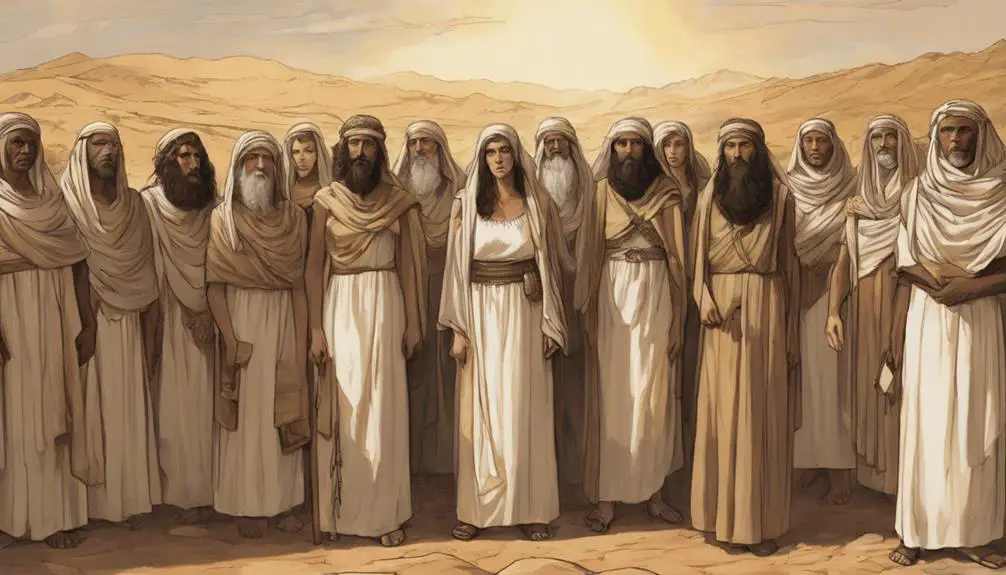
Rarely do biblical narratives spotlight women's rights and agency as poignantly as the story of the Daughters of Zelophehad, who boldly challenged prevailing inheritance laws to claim their father's legacy. This account, found within the book of Numbers, presents a groundbreaking moment in biblical history where women actively sought to amend societal norms regarding land rights.
You encounter Mahlah, Noah, Hoglah, Milcah, and Tirzah, five sisters who, in the absence of a male heir, confronted Moses and the Israelite leadership. Their father, Zelophehad, had died without sons, and according to the laws of the time, his lineage and land were at risk of disappearing. The daughters' petition wasn't merely a personal quest for property; it was a revolutionary act that challenged the patriarchal structures dictating inheritance.
From a feminist interpretation, their story is a testament to the power of women's voices in advocating for change. Their success didn't just secure their father's estate; it prompted a divine command to amend inheritance laws, ensuring women's rights to land and property were recognized.
The Daughters of Zelophehad stand as pioneers, advocating not only for their rights but setting a precedent for future generations. Their story is a powerful reminder of the importance of advocating for justice and equality, even against formidable traditions.
Frequently Asked Questions
How Did the Roles of These Women Warriors and Leaders Influence the Societal Norms Regarding Women's Roles in Ancient Israelite Culture?
You're exploring how certain figures in ancient texts influenced societal norms about women's roles. By engaging in military strategies and being recorded in genealogical records, these women showed that leadership and combat were within the realm of female capabilities.
This presence in critical societal functions gradually shifted perceptions, suggesting women could hold significant responsibilities. Their stories, analyzed faithfully and scholarly, provide insights into evolving gender roles in ancient cultures.
Were There Specific Rituals or Traditions These Women Had to Follow to Be Recognized for Their Acts of Bravery or Leadership Within Their Communities?
You might think rituals and traditions for recognition in leadership roles are modern concepts, but they've been around for ages.
For those stepping into roles of bravery, specific ceremonies and practices were essential. Warrior attire wasn't just about fashion; it symbolized readiness and status. Similarly, combat training was more than physical preparation; it was a rite of passage, embedding values and skills necessary for leadership.
These elements were crucial for acknowledgment within their communities.
How Do Modern Interpretations and Feminist Readings of These Biblical Stories Differ From Traditional Interpretations?
You'll find that modern interpretations often challenge traditional views by breaking down gender stereotypes. Through diverse interpretive methodologies, scholars and feminists offer fresh perspectives on historical narratives, emphasizing women's roles and contributions.
This approach contrasts sharply with older readings that tended to reinforce traditional gender roles. By analyzing texts with a critical eye, you're encouraged to understand the complexities of leadership, bravery, and influence beyond conventional boundaries.
In What Ways Have These Women Warriors Been Represented in Art, Literature, and Popular Culture Throughout History?
Throughout history, you've seen these figures depicted in various forms of art, literature, and popular culture, embodying artistic symbolism and cultural adaptations. Their representations have evolved, reflecting societal changes and ideological shifts.
How Do the Stories of These Women Compare to Those of Female Warriors and Leaders in Other Ancient Cultures and Religions?
You're exploring how tales of female warriors and leaders match up with those from other ancient cultures and religions. Through comparative mythology, you'll find similarities in warrior archetypes, highlighting shared values and beliefs across civilizations.
This analysis reveals a universal appreciation for strength and leadership in women, transcending cultural boundaries. Your scholarly approach ensures a faithful examination of these narratives, offering insights into how societies have historically viewed women in power.
Conclusion
In analyzing the narratives of women warriors in the Bible, you're engaging with a compelling facet of biblical history.
While female warriors aren't the norm, their stories are profound. Interestingly, despite women's limited roles in ancient societies, the Bible records these exceptional instances, providing a powerful testament to their courage and impact.
For example, it's notable that Deborah, a female judge, led Israel to victory—a rare occurrence in a male-dominated era. This highlights the Bible's nuanced approach to gender roles, encouraging a deeper appreciation of its teachings.


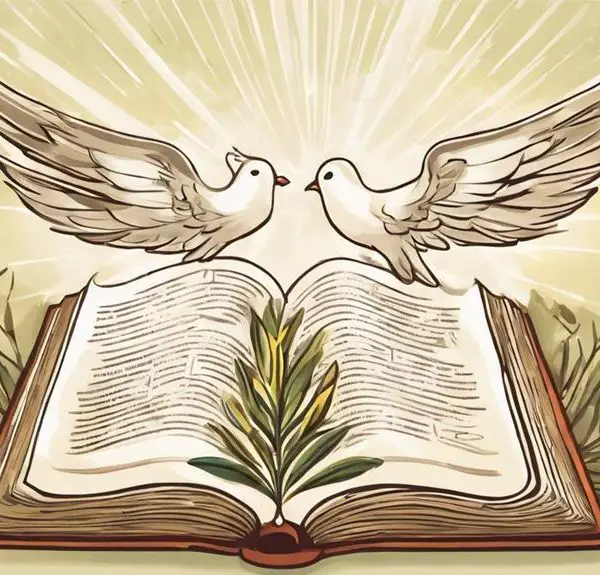
Sign up